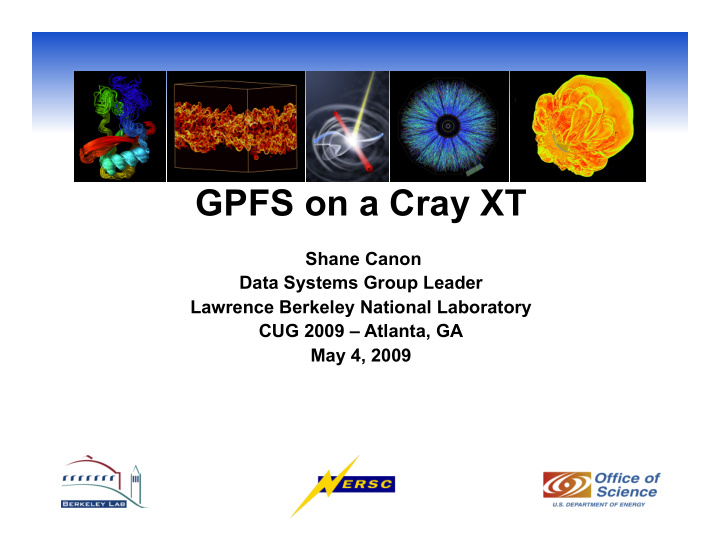



GPFS on a Cray XT Shane Canon Data Systems Group Leader Lawrence Berkeley National Laboratory CUG 2009 – Atlanta, GA May 4, 2009
Outline • NERSC Global File System • GPFS Overview • Comparison of Lustre and GPFS • Mounting GPFS on a Cray XT • DVS • Future Plans
NERSC Global File System • NERSC Global File System (NGF) provides a common global file system for the NERSC systems. • In Production since 2005 • Currently mounted on all major systems – IBM SP, Cray XT4, SGI Altix, and commodity clusters • Currently provides Project space • Targeted for files that need to be shared across a project and/or used on multiple systems.
NGF and GPFS • NERSC signed a contract with IBM in July 2008 for GPFS • Contract extends through 2014. • Covers all major NERSC systems through NERSC6 including “non- Leadership” systems such as Bassi and Jacquard. • Option for NERSC7
NGF Topology Franklin NGF Nodes Ethernet Network NGF- Login FRANKLIN SAN NGF DVS SAN FRANKLIN NGF Disk SAN Compute Node Lustre Bassi Planck pNSD pNSD BASSI Jacq PDSF PDSF Planck Franklin Disk
GPFS Overview • Share disk model • Distributed lock manager • Supports SAN mode and Network Shared Disk modes (mixed) • Primarily TCP/IP but supports RDMA and Federation for low overhead, high bandwidth • Feature rich and very stable • Largest deployment: LLNL Purple 120 GB/s, ~1,500 clients
Comparisons – Design and Capability GPFS Lustre Design Storage Model Shared Disk Object Locking Distributed Central (OST) Transport TCP (w/ RDMA) LNET (Routable Multi-Network) Scaling (Demonstrated) Clients 1,500 25,000 Bandwidth 120 GB/s 200 GB/s
GPFS Architecture TCP TCP Client NSD Server RDMA NSD IB Client Server SAN SAN Client
Lustre Architecture TCP Net1 Client MDS/OSS RDMA Router Net2 Client
Comparisons – Features GPFS Lustre Add Storage ✔ ✔ Remove Storage ✔ Rebalance ✔ Pools ✔ 1.8 (May) Fileset ✔ Quotas ✔ ✔ Disributed Metadata ✔ 3.0 (2010/11) Snapshots ✔ Failover ✔ -With user/third-party assistance
GPFS on Franklin Interactive Nodes • Franklin has 10 Login Nodes and 6 PBS launch nodes • Currently uses native GPFS client and TCP based mounts on login nodes • Hardware is in place to switch to SAN based mount on Login nodes in near future
GPFS on Cray XT • Mostly “just worked” • Install in shared root environment • Some modifications needed to point to the correct source tree • Slight modifications to mmremote and mmsdrfsdef utility scripts (to use ip command to determine SS IP address)
Franklin Compute Nodes • NERSC will use Cray’s DVS to mount NGF file systems on Franklin compute nodes. • DVS ships IO request to server nodes which have the actual target file system mounted. • DVS has been tested with GPFS at NERSC at scale on Franklin during dedicated test shots • Targeted for production in June time-frame • Franklin has 20 DVS servers connected via SAN.
IO Forwarders IO Forwarder/Function Shipping – Moves IO requests to a proxy server running file system client Advantages Disadvantages • Less overhead on clients • Additional latency (for stack) • Reduced scale from FS • Additional SW component viewpoint (complexity) • Potential for data redistribution (realign and aggregate IO request)
Overview of DVS • Portals based (low overhead) • Kernel modules (both client and server) • Support for striping across multiple servers (Future Release-tested at NERSC) • Tune-ables to adjust behavior – “Stripe” width (number of servers) – Block size – Both mount options and Env. variables
NGF Topology (again) Franklin NGF Nodes Ethernet Network NGF- Login FRANKLIN SAN NGF DVS SAN FRANKLIN NGF Disk SAN Compute Node Lustre Bassi Planck pNSD pNSD BASSI Jacq PDSF PDSF Planck Franklin Disk
Future Plans • No current plans to replace Franklin scratch with NGF scratch or GPFS. However, we plan to evaluate this once the planned upgrades are complete. • Explore Global Scratch – This could start with smaller Linux cluster to prove feasibility • Evaluate tighter integration with HPSS (GHI)
Long Term Questions for GPFS • Scaling to new levels (O(10k) clients) • Quality of Service in a multi-clustered environment (where the aggregate bandwidth of the systems exceed the disk subsystem) • Support for other systems, networks and scale – pNFS could play a role – Other Options • Generalized IO forwarding system (DVS) • Routing layer with abstraction layer to support new networks (LNET)
Acknowledgements NERSC Cray • Matt Andrews • Terry Malberg • Will Baird • Dean Roe • Greg Butler • Kitrick Sheets • Rei Lee • Brian Welty • Nick Cardo
Questions?
Further Information For Further Information: Shane Canon Data System Group Leader Scanon@lbl.gov
Recommend
More recommend